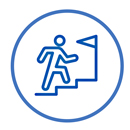Enabling access to care means providing timely, necessary, and appropriate health care services. Nearly all health systems prioritize improving access to care for patients, but many struggle to meet this challenge.
This page features resources that include proven practices, successful strategies, and real-world examples from AAMC-member institutions. Health systems can use the Access to Care Framework, Data Snapshots, and other resources to improve and expand access to ambulatory care.
Access to Care Framework
The Access to Care Framework was developed based on common themes from high-performing organizations.
Initiate

Engaged Leadership
- System growth and access strategy
- Access governance and leadership structure
- Culture
Develop

Structure and Standard Processes
- Scheduling
- Capacity and demand management
- Systemwide policies and work processes
- Data-driven performance improvement

Actionable Data and Analytics
- Metric selection and measurement
- Data integrity
- Data reporting and transparency
Enable

Optimize Care Delivery
- Team-based care
- Population health management
- Performance optimization
- Equitable, patient-centered care

Workforce Engagement
- Onboarding
- Education and training
- Incentives, recognition, and rewards

Leverage Technology
- Electronic medical record optimization
- Virtual health capabilities
- Digital front door
- Artificial intelligence and predictive analytics
Resources
Reports
A Patient-Centered Approach to Optimizing Ambulatory Access: Insights from Leaders in Academic Medicine
This report details the above framework to help health care organizations improve access to care. It features proven practices, successful strategies, and real-world examples from AAMC-member institutions. Learn more.
Learning and Leading in Access to Care: An Overview of Member Collaboratives from the AAMC and Vizient
This report helps in-patient and ambulatory care leaders and staff at U.S. health systems and outpatient clinics understand several national efforts conducted by the AAMC and Vizient to improve access to care in the patient care setting. Learn more.
Data Snapshots
In 2024, AAMC and Vizient surveyed health systems to understand how they are leveraging patient portal communication, including medical advice messages and structured eVisits. The Data Snapshot below highlights these survey results and presents strategies for managing patient portal communication, including approaches to patient engagement, provider workflows, and billing.
- Patient Portal Communication and eVisits
- Full Report: To bill or not to bill: Managing the portal message surge
The Data Snapshots below offer overviews of the variation in data for three ambulatory access measures across Clinical Practice Solutions Center organizations. Each Snapshot also provides specific strategies for improving new patient median lag time, provider and clinic cancellations, and new patient percentage, as well as guidance that health systems can use when evaluating their own data.
- Ambulatory Access Measures: New Patient Median Lag Time
- Ambulatory Access Measures: Provider and Clinic Cancellations
- Ambulatory Access Measures: New Patient Percentage
Other Resources
Innovations in Health Technology: Telehealth
This collection of resources highlights the impact of telehealth in academic medicine, specifically focusing on medical education and training, the clinical delivery system and its workforce, and patients’ access to care. The resources include reports about sustaining telehealth success, including integration imperatives and the AAMC’s telehealth competencies.
eConsults and Enhanced Referrals: Project CORE
Over the last decade, the AAMC has partnered with more than 55 teaching hospitals, children's hospitals, and health care organizations to successfully implement eConsults and enhanced referrals. Through these new tools built into the electronic health record and a robust implementation strategy, Project CORE improves communication and coordination between primary care providers and specialists, enables timelier access to specialty input, and improves value and experience for patients and providers.